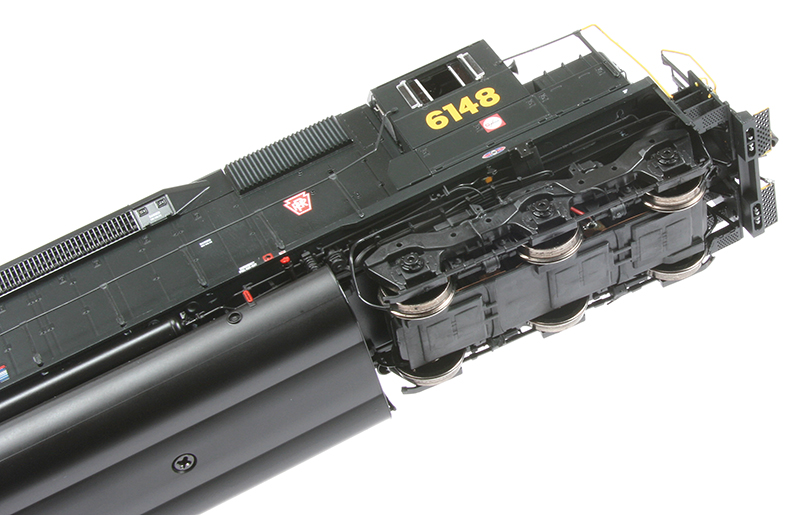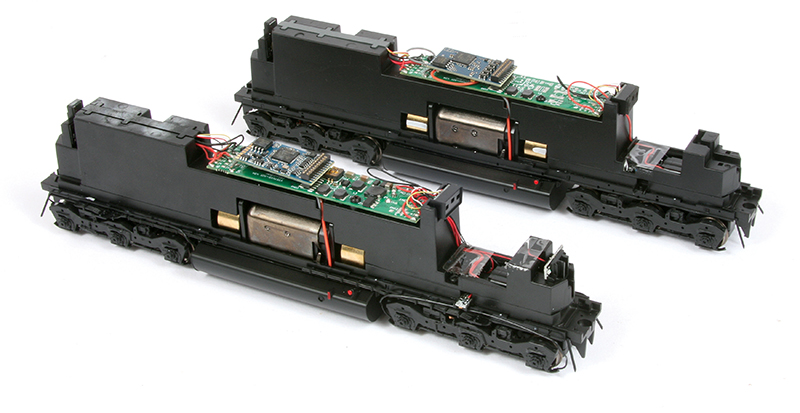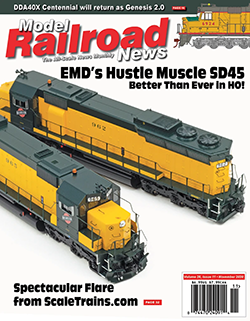
By David Otte
As ScaleTrains.com marks its fifth anniversary, the first chapter of the young model railroad manufacturer’s HO-scale locomotive efforts thus far can best be described as one of “super power.” Out of the gate, the company wowed modelers with its massive Museum Quality General Electric (GE) “Big Blow” Turbine, followed by a stable of Rivet Counter and Operator series high-horsepower six-axle locomotives that span the early 1970s through today: from Electro-Motive Division’s (EMD) SD40-2 and its Tunnel Motor variant to a plethora of GEs, including Dash 8s, Dash 9s, and GEVOs. So it was only natural that the folks at ScaleTrains.com take a brief step back in the motive power history timeline and reflect on the diesel-electric that perhaps had the most influence on the future use of high-horsepower locomotives in North America — EMD’s 3,600-hp SD45 of 1966.
An endeavor as grand as its SD40-2 venture, ScaleTrains.com’s HO-scale SD45 project promises to eventually entail almost as many production-phase attributes, road-specific details, and paint schemes as its more modern 3,000-hp cousin. Available optionally equipped with Digital Command Control (DCC) and sound, ScaleTrains.com’s SD45 is offered as a high-end Rivet Counter and more affordable Operator edition. With the first production run now in the hands of modelers, including River Counter road names Chicago & North Western, Pennsylvania Railroad, Seaboard Coast Line, and Southern Pacific; and Operator Conrail, Pennsy, Southern Pacific, and Santa Fe units, it’s time for us to take a closer look at the revolutionary prototype and this exciting new 1:87 rendering.

ABOVE: Pennsylvania Railroad 6201 remains unmarked by the early 1968 Penn Central merger in this April 1969 view. The road’s SD45 presented a mostly stock representation of EMD’s 3,600-hp unit with few unique or special features, which matched the spartan decoration consisting of multiple Keystone heralds, road number, and radio-equipped emblem. — C. W. Richards photo, Kevin EuDaly collection
EMD’s Hustle Muscle
Feeling the power pinch by General Electric’s Universal Series and Alco’s Century Series by the mid-1960s, EMD unveiled a completely revamped lineup of diesel-electric locomotives in 1966 based on its new 645-series prime mover. In the four-axle department were 2,000-hp GP38 and 3,000-hp GP40 diesels, with six-axle entries including 2,000-hp SD38 and 3,000-hp SD40 — all powered by the two-stroke 16-cylinder version of the 645 engine and being either Roots blown (normally aspirated) or turbocharged for the different power output. Setting out under its own spotlight, however, was a monster of a locomotive referred to as the SD45. At a whopping 3,600-hp, this six-axle behemoth put EMD back on top of the horsepower race between the big three and, for the first time, saw a 20-cylinder engine become a reliable prime mover in the railroad industry.
There had always been a sense of skepticism among railroad men that an engine with more than 16 cylinders powering a locomotive would lead to crankshaft failures and other maintenance headaches. The design engineers at EMD, though, feeling the pressures of competition, needed to push their 645-series engine to the next level if they were ever going to take the lead in this horse race. Putting their own trepidations aside, the story goes that the designers only needed to look toward the Japanese ship building industry for encouragement. Their counterparts in the Far East had successfully managed to create a 20-cylinder V-type marine engine that proved such a design could not only be achieved, but be put into widespread regular practice too; so the boys at EMD got down to work.
The resulting 20-645E3 prime mover was installed in three SD45 demonstrators by January 1966 and sent out on the road for testing. At 65 feet 8 inches over its coupler pulling faces, EMD’s SD45 exhibited a much longer frame than previous SD units, one that was shared with the entire new catalog of offerings: SD38, SD40, and SD39 models. The SD45 appeared larger, however, as its hood took up a greater length of the frame. Yet the most distinctive feature of the SD45 was the angled radiator grilles jutting out from the upper rear of the long hood. This arrangement was the end result of EMD engineers needing to increase the radiator cooling area within the confines of the existing space; setting the radiators on an angle allowed for more height while maintaining the same vertical dimension used in the SD40. In addition, a later outgrowth of this model would be EMD’s dual service SDP45, the frame of which was stretched an additional five feet for inclusion of steam generator equipment for passenger train service.
Successful testing of the new six-axle units convinced the railroads of the merits of the 20-cylinder engine, an industry at the time fixated on more horsepower per unit, with their newfound confidence resulting in big returns for EMD. Advertised by the builder as “super power” that can “run like a race horse” and “drag like a mule,” orders started pouring in almost immediately for the 3,600-hp diesel locomotive, with Great Northern (GN) first to step up to the plate. In May 1966, the Hill road received eight SD45s numbered 400–407 with the class leader carrying the nickname “Hustle Muscle” on its sides, forever immortalizing the 20-cylinder SD45 in the minds of railfans. Great Northern’s marketing department was quick to take advantage of the road’s new purchase and in magazine and newspaper ads titled “Hustle Muscle” they touted, “Who’s first with America’s most powerful single-engine diesel locomotive? Great Northern, that’s who!”
And with its great muscle and hustle, the SD45 grew to become one of EMD’s best-selling locomotives. Although at slower speeds it had about the same continuous tractive effort as the 3,000-hp SD40, the SD45’s extra 600-hp came into play in bringing a train up to maximum main line speeds. Thus, it was not necessarily efficient for an SD45 to be assigned to a long slow-moving coal drag, for example, but rather it was better suited for powering time-sensitive general-merchandise trains. By the time the last unit rolled off the assembly line in December 1971 — Burlington Northern number 6567 — a total of 1,260 SD45s had been erected with an additional 52 SDP45s delivered as well. After EMD’s introduction in 1972 of its “Dash 2” line consisting of new electrical and control upgrades, the SD45 would be replaced by the SD45-2 and its famous “tunnel motor” variant, the SD45T-2.
Within a few years of operation, though, a weakness in the SD45’s engine block was unfortunately discovered, which allowed the crank shaft to flex and eventually fail; those early industry naysayers appeared to be proven right. In time, EMD was able to overcome this issue by means of a redesign, the 645F model engine, but the damage to the 20-cylinder’s reputation was already done. Additionally, the SD45 consumed a greater amount fuel than SD40s did when left to idle between assignments, which was a typical railroad practice during this time. Doubting reliability and efficiency, some roads quickly traded in or sold off their units while other owners often chose to re-engine their SD45s with 16-cylinder prime movers.
While the SD45 garnered the most attention as the mid-1960s horsepower race was in full swing, by the end of the decade and with these weakness ultimately defining the 3,600-hp locomotive, the 16-cylinder 3,000-hp SD40 and its Dash 2 successor would emerge as the locomotive of choice for the majority of railroads. Yet this was only a bump in the path to even higher horsepower diesel-electrics. As locomotive builders took advantage of new computer-age technologies, much more powerful and efficient designs would see six-axle 4,000-hp and greater diesel-electrics become the norm by the end of the 20th century.
ScaleTrains.com’s SD45
For me, the SD45 was the “sport model” within EMD’s 1966 lineup. Perhaps it’s those flared radiator grilles and longer rear hood making it more of a standout, but the locomotive just looks faster when compared to the SD40, for example. And this appearance has been perfectly captured by ScaleTrains.com in its HO-scale rendering. As expected from this manufacturer, the model reflects all the proper general dimensions of the prototype without exception. The injection-molded hoods, cab, fuel tank assembly, and walkway components all show excellent molded-in features matching the real deal, from the minute hinges found on the access doors to the delicate tread plate pattern present on the end platforms.
For the Rivet Counter versions, a plethora of standard add-on parts are visible too, such as: wire-formed grab irons; rooftop lift rings; fine photo-etched cooling fan grilles; cut levers and multiple unit and train line air hoses on the pilots; sliding side windows in the cab and exterior wind screens; photo-etched windshield wipers; conduit and plumbing runs along the side sills; and truck sideframes exhibiting speed recorders and sanding lines. Of course, this manufacturer has made a name for itself in providing modelers with highly accurate road-specific offerings, so many of these and other details aren’t just random additions, but reflect production phase and railroad ownership practices as well — some very subtle in appearance. To better appreciate this aspect of the ScaleTrains.com SD45, an overview of changes during the production life of the prototype is in order.
It’s been determined by railfans that the major demarcation in production phases involves the pilot design. This attribute includes both the appearance of the end plate and height of the first step to the end platform. Early SD45s, Phase I units built prior to July 1967, exhibited a pilot end plate with a nub extending out from the edges near the bottom while its associated first step is mounted rather high. After this date, EMD changed the end plate to more of a zig-zag pattern on the outer edges as it related to the new lower first step arrangement, Phase II. Finally, by November 1971 and near the end of production, the builder redesigned the pilot yet again, which continued the lower first step, but the end plate now displayed a straight edge with bottom step tab — Phase III.

ABOVE: The Rivet Counter SD45 is blessed with a detailed underbody with traction motor cables and plumbing running the length of the side sills; the fuel lines and air reservoir with Salem accordion style filter; the correct fuel tank single filler pipe and gauge arrangement; and beautifully rendered Flexicoil trucks that display the early low mounted brake cylinder locations plus sanding lines. This version of the HO-scale SD45 even features working ground lights over the lead truck and, as is apparent in this view, see-through photo-etched step treads. Outstanding!
While at first glance the pilot appearance seems simple enough to keep track of, unfortunately, SD45 aficionados have discovered numerous sub variations to each production phase. This long list of characteristics includes: the handbrake style and location — ratchet style on the left side of the short hood or brake wheel on rear right side of long hood; the brake cylinder positioning on the Flexicoil 3-axle trucks — low, high or a combination of both; the traction motor walkway ducting — first long then shortened, extending down the left walkway with accompanying altered handrail stanchion locations; the inclusion of an electrical cabinet air filter box (ECAFB) mounted directly behind the left side of the cab and a rooftop dynamic brake vent; short or long taper on the front of the dynamic brake housing; “chicken wire” or rectangular shaped wire mesh covering the radiator intake grilles; smooth or ribbed blower duct housing; and even the shape of the handholds on the nose, which could be either straight or drop grabs. The list goes on, but I think you get the picture; it’s another big undertaking for ScaleTrains.com in correctly rendering every railroad-owned SD45 to ever ply the rails. Given time, however, I think the company can accomplish this feat based on what I’m seeing with our current samples and ScaleTrains.com’s past track record with its SD40-2 offerings. Let’s delve into our Pennsy Rivet Counter and Conrail Operator series examples.
By the mid-1960s, PRR management became committed to the high-horsepower six-axle diesel for freight service with 2,800–3,600-hp road switchers dominating its 1966 and 1967 locomotive orders; in fact, the SD45 accounted for half of them. The first group of 65 units, numbered 6105-6169, arrived on the scene starting in October 1966, with a second group of 60 SD45s following between December 1967 and January 1968. Carrying the class designation EF-36, five additional units included in the final order were delivered starting in February 1968 — after the Penn Central merger took effect and thus are not officially included in the PRR roster. It’s also worth noting that ten of the later Pennsy units were equipped for the then ground-breaking radio-controlled unit experiment with five units outfitted with radio transmitters and the other half with receivers.
As the EF-36 class was assigned to PRR’s Enola locomotive terminal, these dynamic brake equipped SD45s were used primarily in main line freight service during their rather short stint on the road. Keeping their same road numbers, Pennsy’s fleet of SD45s would continue on the same course under Penn Central management and all would be transferred to Conrail upon its startup in April 1976, still wearing their same Pennsy road numbers. The ex-PRR SD45s would continue to serve Conrail until retirement between 1979 and 1986. Some of these SD45s would coincidentally end up working for Chicago & North Western while others became a source for rebuilds by Morrison-Knudson, whereby their prime movers were replaced with more reliable 16-cylinder 645 engines and the units upgraded to SD40-2 standards. Redesignated SD40M-2s, the units would see additional service on CSX, Southern Pacific, and Union Pacific. For both the initial PRR and Conrail offerings, ScaleTrains.com is sticking with the first group of units from the 6105-6169 series. Delivered by January 1967, these SD45s all displayed the early pilot/step arrangement and are thus Phase I examples. But that’s not all. Further investigation reveals that this group also exhibited: “chicken wire” radiator grille mesh; the early short-tapered dynamic brake blister; long walkway duct; smooth blower duct housing; rear handbrake location; and all low mounted brake cylinders on their Flexicoil trucks. Thus, these units can further be classified per railfans as Phase Ib1.
The same attention to detail is carried over to decoration. The as-delivered PRR unit reflects railroad practice at a time when the merger with New York Central was on the horizon. Sticking with its Dark Locomotive Green Enamel carbody color (also referred to as Brunswick Green), only five red and white reflective Keystone heralds were worn by the SD45s, which could easily be removed and replaced with the new Penn Central logos when the time came. Other than that, only a road number in Buff Lettering Color was carried on the cab sides with a small square “Radio” equipped badge beneath and EMD builder’s plate below on the sill. ScaleTrains.com has replicated these paint and lettering applications on its 1:87 version quite well, along with the occasional warning label in white lettering dotting the long hood sides, the ACI labels placed on the middle engine access doors, the handrail at the stepwells painted safety yellow, and the flush mounted emergency fuel cut off button, fuel filler cap, and tank gauge highlighted in red paint.

ABOVE: This comparison shot of the Rivet Counter (foreground) and Operator series SD45 interiors displays the models’ shared die-cast metal chassis and common all wheel drive mechanism, but the different sound decoder setups — LokSound 5 with dual cube speakers (hidden inside the rear weight) in the Rivet Counter version and ESU Essentials with oval speaker in the Operator model. The additional LED lighting boards (on either side above the lead truck and marker lights in hood ends) included on the Rivet Counter rendering are another indication of the $100 price difference between the two offerings. For shell removal, simply disassemble the coupler boxes from the frame and slide off the carbody.
The Ultimate Hustle Muscle Indeed
I think it’s pretty easy to see from the above critique that ScaleTrains.com’s new Rivet Counter SD45 is indeed the ultimate Hustle Muscle. Sure, we’ve seen HO-scale SD45 models from a number of model railroad manufacturers in the past, some even with road-specific details, but none to this degree of accuracy as it relates especially to production phases. The Operator version also has much to offer the hobbyist on a budget, with the dangling carrot of a future detailing upgrade through the aftermarket SD45 Detail Kit. About the only aspect of this new prototype that’s kind of a downer from my perspective is having enough patience to wait for the specific road name one desires (undecorated models are available for modelers who just can’t wait)! Not to fret, though, the manufacturer is hustling to get more paint schemes to us pronto with a second wave of both Rivet Counter and Operator models slated for arrival in early 2021.
ScaleTrains.com
844-987-2468
ScaleTrains.com




